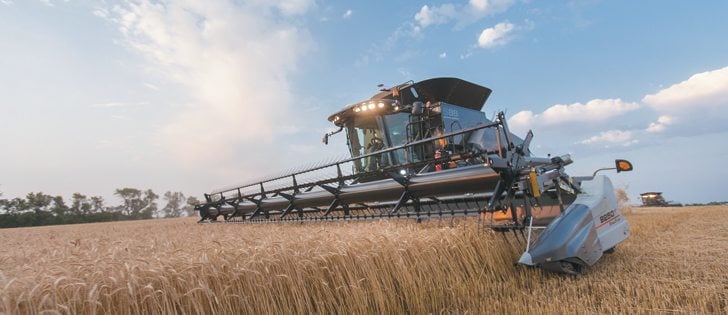Lighter weight, increased capacity | Gradual changes in the components and design result in new combines, over time
Rather than going back to the drawing board every few years, Agco believes in the gradual evolution of its combines, focusing each new enhancement on the weakest link in the chain.
This year, the company used the Farm Progress Show in Boone, Iowa, and Big Iron in Fargo, North Dakota, to introduce major upgrades to its Gleaner and Massey combines.
Engine selection is one example of Agco’s gradual approach.
As of last January, every Agco product is now powered by an Agco engine. The only exception is the compact tractor line.
Read Also

Saskatchewan project sees intercrop, cover crop benefit
An Indigenous-led Living Lab has been researching regenerative techniques is encouraging producers to consider incorporating intercrops and cover crops with their rotations.
Agco bought the Finnish engine company Sisu in 1994, which was recently renamed Agco Power. Sisu engines immediately began powering Agco implements, and the full line of Agco-built implements now has Agco Power.
All 2015 model year combines are Tier 4 compliant, with diesel exhaust fluid, selective catalytic reduction and dual turbochargers with external-cooling ECR. The engines do not use diesel particulate filters.
The Class 6 combines in the Gleaner and Massey lineup are powered by the 8.4 litre, six-cylinder engine rated at 322 horsepower with maximum 398 h.p. boost.
The Class 7 machines have the 9.8 litre, seven-cylinder engine rated at 375 h.p. and 451 h.p. maximum boost.
The Class 8 Massey also has the 9.8 litre, seven-cylinder engine, but the rating is 460 h.p. with maximum 490 h.p. boost.
The Class 8 Gleaner is a lighter weight combine and has a straight through gearbox, which means the same 9.8 litre engine only has 430 h.p. with maximum 471 h.p. boost.
All Gleaner and Massey combines can be equipped ready for Ag Leader as a factory option, which allows for yield monitoring with a live yield map.
The option includes an elevator mount unit, yield sensor, moisture sensor, speed module and harness. Farmers need only add the Ag Leader display of their choice.
Gleaner S8 Super Series
The 32,000 pound transverse rotary Gleaner S8 is still at the bottom of the class when it comes to weight.
“Gleaner is the lightest combine platform in the world,” says Agco combine specialist Kevin Bien.
“The S88 is nearly eight tons lighter than competitive Class 8 combines. We save weight because the natural flow rotor design requires fewer components.”
Bien said the straight-through gearbox gives Gleaner an automatic energy advantage over combines with a 90 degree gearbox because the 90 degree change in power direction is inherently inefficient.
“There are greater parasitic losses with any 90 degree gearbox than with a straight-through gearbox. That goes without saying. The more power you try pulling through that 90 degree gearbox, because of the en-gine location, the more power you lose.
“The 90 degree gearbox is also more difficult to service. If I’ve got a New Holland CR and I have to service the gearboxes that drive the twin rotors, I have to get inside the cleaning shoe. Now that’s a major job.
“Whereas, if I’ve got a Gleaner with a straight-through shaft, the power requirement is less, the combine weighs less and I’m servicing it from the outside.”
Concave filler plates are now available to boost threshing performance in wheat and other small grains. New separator blanking is available, with three blanks for maximum performance in grass seed, sunflowers and specialty crops.
A perforated elevator door makes harvesting soybeans and edible beans in sandy conditions a much cleaner operation. The clean grain elevator drive is six percent faster and handles more than 5,000 bushels per hour of dry corn.
The S8 has increased capacity for farmers wanting to get out early and harvest high-moisture crops. A perforated cascade pan for the cleaning shoe provides a 12.8 percent increase in pneumatic cleaning area to provide cleaner grain in the tank and lower losses in the field.
“This area used to be solid, so grain would come up the rotor,” Bien said.
“If I was threshing high moisture grain, it would stick for quite a while before it fell down to chaffer and the sieve.
“Now that we have a perforated pan, the high moisture grain falls down to the cross auger very easily. Also, the show used to be 7,729 sq. inches. Now it 8,721 sq. inches.
“It’s a huge improvement in capacity. If I had been running 4,000 bu. per hour high moisture corn before, now I can run 4,400 bu. per hour.”
For farmers interested in conservation tillage, the straw spreader motor was moved two inches to the rear for better straw and residue discharge.
Other changes are designed to reduce spreader curtain and paddle wear by 50 percent.
The new Gleaners get a higher-capacity rear-wheel assist steering control unit, with a larger cylinder to help in fully loaded conditions.
The combines keep their unitized, welded main frame, which provides a low centre of gravity and true centerline design for better handling in adverse field conditions.
Massey 9505 Series
Bien said the Massey 9505 axial weighs 39,000 to 40,000 lb. and is simple design compared to many other combines.
The 9505 couples the Trident processor with a new variable-speed hydraulic-drive fan that’s adjustable from 100 to 1,350 r.p.m.
Extending the r.p.m. fan-speed range eliminates the need to switch pulleys for different crops.
Massey also added perforated panels at the bottom of the shoe for soybeans, edible beans and other harvest conditions in which sand and dirt get into the combine.
“The bottom of the shoe has the capability to run these perforated panels down below the auger trough to take out the fines,” he said.
“They give the cleaning shoe area a chance to clean out when you’re cutting low and bringing dirt into the combine.”
Agco said the panels allow better control of material distribution on the shoe to improve rotor and shoe performance and improve material distribution in the separation and threshing areas.
There’s more to bumping up the power on a combine than simply turning the screw on the software.
Components must be strong enough to survive and take full ad-vantage of the new-found power when running those large headers in tough conditions.
The new 9505 provides 28 percent more power to the variable-speed header drive, which has been up-graded to take the extra torque.
Massey uses the same V-Cool system, which places the radiator, hydraulic-cooling heat exchangers and air-to-air intercooler in a V-shape below a variable-speed, hydraulically driven fan, which draws only as much power from the engine as needed.
It still includes the purge reverse cycle to clear off chaff and other debris.
Bien said a new grain-saver option on the unloader auger is designed to prevent grain from falling to the ground when the auger is shut off while it’s full of grain.
“We have a grain cart type of unloader tube that swings out. Normally, when you shut off the auger to swing it back in, you tend to lose some grain at the end of the tube.
“Now we have a power driven rotating spout at the end. It rotates to the top side and lets you swing the tube back in with the spout pointing to the inside so you don’t lose clean grain. It rotates whether the unloading auger is engaged or disengaged.”
The cab has a new layout, new steering column and enhanced ergonomic control placement. Agco said the changes provide the operator with better visibility.
For more information, visit www.masseyferguson.us or www.GleanerCombines.com.
















